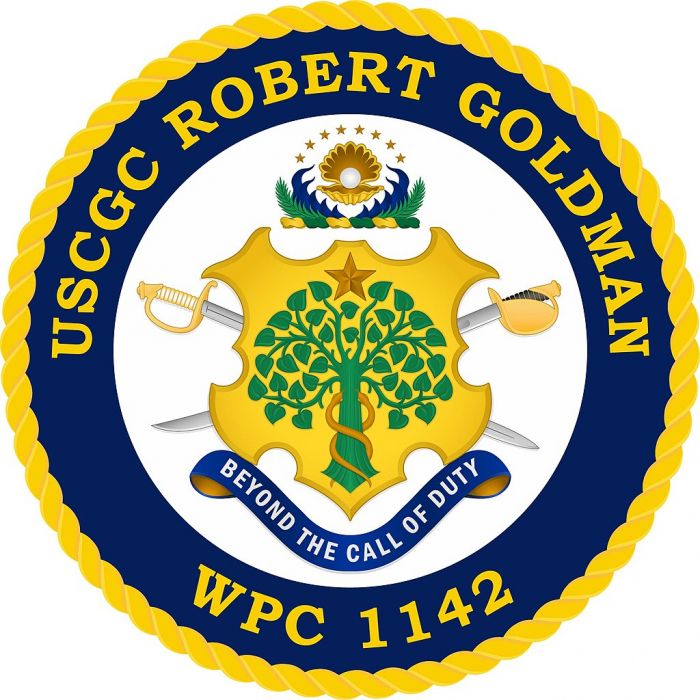
(As we get into this, you may want to click on the photo to get an enlarged view.)
This Spring, the first two Webber class patrol craft are expected to go to Bahrain to start replacing the six 110 foot WPBs of Patrol Force South West Asia (PATFORSWA). Two more will join them in the Fall and the last two in 2022. Back in 2018, I speculated on what might be done to modify them for duty in this more dangerous area. Apparently the Coast Guard leadership has had a few ideas of their own.
We have some very shape observers among the readers of this blog.
First Andy provided the photo of USCGC Charles Moulthrope (WPC-1141) above and pointed out the Long Range Acoustic Device (LRAD, the gray device mounted near rail on the O-1 deck just this side of the port forward corner of the bridge) and the four round sensors a short way up the mast two on each side. I note these systems were not on the ship when it was handed over by Bollinger (photo below).

The 41st fast response cutter (FRC), Charles Moulthrope, as delivered to the Coast Guard in Key West, Florida, Oct. 22, 2020. It is the first of six planned FRCs to be stationed in Manama, Bahrain. (U.S. Coast Guard photo)
Then Secundius identified the four round sensors on the mast as Sierra Nevada Modi RPS-42 S-Band Radar.

From the Company web site: “RPS-42 is an S-Band tactical hemispheric air surveillance radar system. It is a member of the non-rotating, solid-state, digital radar family Multi-mission Hemisphere Radar (MHR), developed by RADA Electronic Industries Ltd.
“The RPS-42 is a pulse Doppler, software-defined radar platform, that can detect, classify and track all types of aerial vehicles – including fighters, helicopters, UAVs, transport aircraft, etc. at tactical ranges. A single radar platform provides 90º azimuth coverage. Hemispheric coverage is achieved when four radars are employed as a system. Mobile or stationary, the system can be integrated with any C⁴I system and other radars and sensors. The software is able for On-the-Move (OTM) Operation. The radar can operate either as a stand-alone or as part of a large-scale surveillance system.
“The Antenna is an Active Electronically Scanned Array (AESA) based on Galliumnitrid (GaN) Amplifiers. Its diameter is 50.4 cm , the max width is 16.5 cm. (19.8″ x 6.5″ –Chuck)
“The achievable range for detection of the smallest drones (known as Nano UAV) is 3.5 km”
These radars use Galliumnitrid (GaN), the new technology in radar, that allows the AN/SPY-6 to significantly outperform the earlier AN/SPY-1 found on most Aegis equipped warships. (Reportedly a 3000% improvement)
You can get an appreciation of what this is about from this Popular Mechanics article. This Is the ATV-Mounted Jammer That Took Down an Iranian Drone.
There is more here: Light Marine Air Defense Integrated System [LMADIS] (globalsecurity.org)
I’m only guessing, but I would think the FRC would also have the same or equivalent complementary equipment as the LMADIS, e.g. small EO/IR camera, Skyview RF Detection system and Sierra Nevada MODi RF jammer (Photo below, I may be seeing the jammer–pictured below–located above and behind the port side RPS-42 radar arrays, visible between the radar arrays and the tripod legs). The cutters of this class are already normally equipped with electro-optic devices, both on the mast and on the Mk38 gun mount, which can provide a kinetic counter to UAVs.

Sierra Nevada MODi RF jammer. From the company web site, “SNC’s Modi II is the most modern & highly-capable dismounted EMC system in the DOD inventory.”
This was probably what the Commandant was talking about, when he said that Coast Guard PATFORSWA had a counter UAS role in a recent interview.
I am thinking, this radar might also be used on some of our other cutters as well, perhaps the 210s and the six 270s to be FRAMed, to provide them better control of their helicopters on approach in bad weather. The 210s have no air search radar and the 270s will almost certainly lose the Mk92 fire control system which provides their only air search radar currently. Reportedly the radar has a range of up to 30km and an instrumented range of 50km at altitudes from 30ft to 30,000 feet. Apparently the Marines are also using it to direct fire for their short range air defense systems. which includes a 30mm gun and Stinger missiles.
Thanks to Andy and Secundius for kicking this off.

















